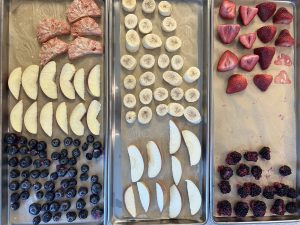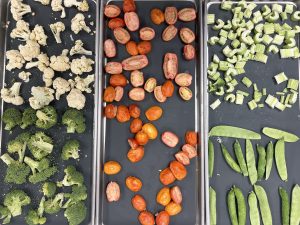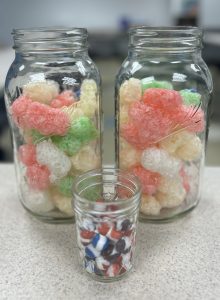
Tips for Freeze Drying at Home
— By Kate McCarty, Food System Professional, University of Maine Cooperative Extension
Freeze drying is becoming a popular method of home food preservation as freeze dryers designed for home use are becoming more widely available. Most foods can be freeze dried, from fruits and vegetables to proteins and complete meals. Freeze drying removes up to 98% of moisture from food and when stored properly lasts for a long time. Freeze dried foods can either be enjoyed as a crunchy snack or rehydrated to use in meals.
We recently purchased a home freeze dryer from Harvest Right, a company in Utah. We bought a medium-sized unit, as well as the required oil pump and food trays, and accessories like a vacuum sealer, mylar bags, oxygen absorbers, and silicone tray liners. The freeze dryer works by first freezing the food and then creating a vacuum inside the frozen chamber. This combination of cold temperatures and a vacuum rapidly pulls most of the moisture from the food, resulting in dehydrated foods that look relatively like they did when they were fresh.
We have been experimenting with freeze drying different kinds of foods—first with fruits like berries, citrus slices, pineapple chunks, and apple slices. It all came out great, but our personal favorite was the pineapple, with great flavor and a light, airy, crunchy texture. Then we tried vegetables—celery, broccoli, cauliflower, sugar snap peas, and cherry tomatoes. Again, they were all a hit, both for eating raw or rehydrating in meals. We even tried a bit of leftover homemade macaroni and cheese, and it was so fun to see the results—it looked relatively unchanged but was so dry and crunchy!


Finally, we had to try and freeze dry candy. Freeze dried candy has appeared in my social media feeds, and I even saw a bag for sale at the grocery store. Skittles and gummy bears seem to be popular, so we dried a bag of each. This process uses the candy setting on the machine and dries at a higher temperature, which is different from fruits and vegetables that have higher moisture content. The Skittles puffed up and became crunchy, while the gummy bears bubbled and inflated into airy puffs. We enjoyed them in the office as a fun novelty treat.

Now that we’ve tried a few rounds of different types of foods in our freeze dryer, here are some tips for freeze drying at home that we learned.
Before Freeze Drying
- Wash your produce well before preparing and follow proper food handling to ensure food safety of your finished product. Freeze drying does not destroy harmful bacteria that can cause foodborne illness, so be sure to wash food well, use produce that is ripe and not moldy or damaged, and cook meat and eggs to appropriate internal minimum temperatures before eating them.
- Light-colored fruit like apples, bananas, and pears can be pretreated to prevent browning once it’s cut. Pretreat by soaking in diluted lemon juice or an ascorbic acid dip, as recommended in Penn State’s Let’s Preserve Drying fact sheet. This step is for appearances, so you can skip it if the slight browning of the sliced fruit doesn’t bother you.
- Most vegetables need to be blanched before being freeze dried. This step of briefly boiling vegetables helps to prevent changes to color, texture, and flavor, caused by enzymes, during long term storage. The exception is tomatoes, peppers, and onions, which don’t need to be blanched before being freeze dried. Recommendations for blanching times can be found in the Let’s Preserve Drying fact sheet.
- Read the freeze dryer’s instructions well before you begin. There are several steps in the freeze drying process that if not done in the correct order can damage your machine and void the manufacturer’s warranty. Be sure to keep up with regular maintenance, such as changing the oil in the oil pump when required. We created a log to keep track of when maintenance is needed and completed.
After Freeze Drying
- Properly storing your freeze dried foods is important—because they are so dry, they will readily absorb moisture from the surrounding air. Vacuum sealed mylar bags are the best way to get the highest quality freeze dried foods. If you are planning to eat your freeze dried foods soon, glass or plastic containers with an airtight lid will also work well.
- Some people like to enjoy freeze dried vegetables as snacks. If you want to snack on thinly-sliced veggie chips (beets, sweet potatoes, summer squash, and zucchini work well), you will want to season these foods after they are freeze dried. Add a little bit of oil (an oil spray works well) and sprinkle with spices, herbs, or nutritional yeast for flavor. Know that freeze dried foods will absorb water from your body as you consume them, so be sure to drink lots of water if you are snacking on these foods.
No endorsement of products or companies is intended, nor is criticism of unnamed products or companies implied.
